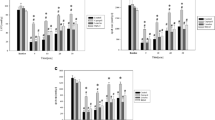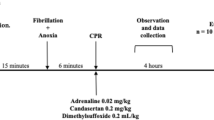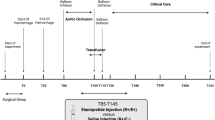Abstract
Acute pulmonary embolism (APE) has a very high mortality rate, especially at cardiac arrest and even after the return of spontaneous circulation (ROSC). This study investigated the protective effect of the angiotensin-converting enzyme (ACE) inhibitor captopril on postresuscitation hemodynamics, in a porcine model of cardiac arrest established by APE. Twenty-nine Beijing Landrace pigs were infused with an autologous thrombus leading to cardiac arrest and subjected to standard cardiopulmonary resuscitation and thrombolysis. Ten resuscitated pigs were randomly and equally apportioned to receive either captopril (22.22 mg/kg) infusion or the same volume saline, 30 min after ROSC. Hemodynamic changes and ACE-Ang II-angiotensin II type 1 receptor (AT1R) and ACE2/Ang-(1-7)/Mas receptor axis levels were determined. APE was associated with a decline in mean arterial pressure and a dramatic increase in pulmonary artery pressure and mean right ventricular pressure. After ROSC, captopril infusion was associated with significantly lower mean right ventricular pressure and systemic and pulmonary vascular resistance, faster heart rate, and higher Ang-(1-7) levels, ACE2/ACE, and Ang-(1-7)/Ang II, compared with the saline infusion. The ACE2/Ang-(1-7)/Mas pathway correlated negatively with external vascular lung water and pulmonary vascular permeability and positively with the right cardiac index. In conclusion, in a pig model of APE leading to cardiac arrest, captopril infusion was associated with less mean right ventricular pressure overload after resuscitation, compared with saline infusion. The reduction in systemic and pulmonary vascular resistance associated with captopril may be by inhibiting the ACE-Ang II-AT1R axis and activating the ACE2/Ang-(1-7)/Mas axis.






Similar content being viewed by others
Abbreviations
- ACE:
-
Angiotensin-converting enzyme
- Ang:
-
Angiotensin
- APE:
-
Acute pulmonary embolism
- AT1R:
-
Angiotensin II type 1 receptor
- MAP:
-
Mean arterial pressure
- PAP:
-
Pulmonary artery pressure
- RAS:
-
Renin-angiotensin system
- ROSC:
-
Return of spontaneous circulation
- SVR:
-
Systemic vascular resistance
References
Dias CA Jr, Neto-Neves EM, Montenegro MF, Tanus-Santos JE (2012) Losartan exerts no protective effects against acute pulmonary embolism-induced hemodynamic changes. Naunyn Schmiedebergs Arch Pharmacol 385:211–217. doi:10.1007/s00210-011-0695-x
Ferreira AJ, Santos RAS (2005) Cardiovascular actions of angiotensin-(1–7). Braz J Med Biol Res 38, 499-507. doi:/S0100-879X2005000400003
Fraga-Silva RA, Da Silva DG, Montecucco F, Mach F, Stergiopulos N, da Silva RF, Santos RA (2012) The angiotensin-converting enzyme 2/angiotensin-(1-7)/Mas receptor axis: a potential target for treating thrombotic diseases. Thromb Haemost 108:1089–1096. doi:10.1160/TH12-06-0396
Haga S, Tsuchiya H, Hirai T, Hamano T, Mimori A, Ishizaka Y (2015) A novel ACE2 activator reduces monocrotaline-induced pulmonary hypertension by suppressing the JAK/STAT and TGF-β cascades with restored caveolin-1 expression. Exp Lung Res 41:21–31. doi:10.3109/01902148.2014.959141
Heit JA III, Silverstein MD, Mohr DN, Petterson TM, O’Fallon WM, Melton LJ III (2000) Risk factors for deep vein thrombosis and pulmonary embolism: a populationbased case-control study. Arch Intern Med 160:809–815. doi:10.1001/archinte.160.6.809
Ilieva I, Ohgami K, Jin XH, Suzuki Y, Shiratori K, Yoshida K, Kase S, Ohno S (2006) Captopril suppresses inflammation in endotoxin-induced uveitis in rats. Exp Eye Res 83:651–657. doi:10.1016/j.exer.2006.03.005
Johnson JA, West J, Maynard KB, Hemnes AR (2011) ACE2 improves right ventricular function in a pressure overload model. Plos one 6:e20828. doi:10.1371/journal.pone.0020828
Kudlička J, Mlček M, Hála P, Lacko S, Janák D, Hrachovina M, Malík J, Bělohlávek J, Neužil P, Kittnar O (2013) Pig model of pulmonary embolism: where is the hemodynamic break point? Physiol Res 62:S173–S179
Konstantinides SV, Torbicki A, Agnelli G, Danchin N, Fitzmaurice D, Galiè N, Gibbs JS, Huisman MV, Humbert M, Kucher N, Lang I, Lankeit M, Lekakis J, Maack C, Mayer E, Meneveau N, Perrier A, Pruszczyk P, Rasmussen LH, Schindler TH, Svitil P, Vonk Noordegraaf A, Zamorano JL, Zompatori M, Task Force for the Diagnosis and Management of Acute Pulmonary Embolism of the European Society of Cardiology (ESC) (2014) 2014 ESC guidelines on the diagnosis and management of acute pulmonary embolism. Eur Heart J 35:3033–3069. doi:10.1093/eurheartj/ehu283, 3069a-3069k
Li Y, Zeng Z, Li Y, Huang W, Zhou M, Zhang X, Jiang W (2015) Angiotensin-converting enzyme inhibition attenuates lipopolysaccharide-induced lung injury by regulating the balance between angiotensin-converting enzyme and angiotensin-converting enzyme 2 and inhibiting mitogen-activated protein kinase activation. Shock 43:395–404. doi:10.1097/SHK.0000000000000302
Marcus JT, Gan CT, Zwanenburg JJ, Boonstra A, Allaart CP, Götte MJ, Vonk-Noordegraaf A (2008) Interventricular mechanical asynchrony in pulmonary arterial hypertension: left-to-right delay in peakshortening is related to right ventricular overload and left ventricular underfilling. J Am Coll Cardiol 51:750–757. doi:10.1016/j.jacc.2007.10.041
McIff TE, Poisner AM, Herndon B, Lankachandra K, Molteni A, Adler F (2011) Mitigating effects of captopril and losartan on lung histopathology in a rat model of fat embolism. J Trauma 70:1186–1191. doi:10.1097/TA.0b013e3181e50df6
Mizera R, Hodyc D, Herget J (2015) ROS scavenger decreases basal perfusion pressure, vasoconstriction and NO synthase activity in pulmonary circulation during pulmonary microembolism. Physiol Res 64:683–688
Pereira DJ, Moreira MM, Paschoal IA, Martins LC, Metze K, Moreno Junior H (2001) Near-fatal pulmonary embolism in an experimental model: hemodynamic, gasometric and capnographic variables. Rev Bras Cir Cardiovasc 26:462–468
Pantazopoulos IN, Xanthos TT, Vlachos I, Troupis G, Kotsiomitis E, Johnson E, Papalois A, Skandalakis P (2012) Use of the impedance threshold device improves survival rate and neurological outcome in a swine model of asphyxial cardiac arrest. Crit Care Med 40:861–868. doi:10.1097/CCM.0b013e318232d8de
Smulders YM (2000) Pathophysiology and treatment of haemodynamic instability in acute pulmonary embolism: the pivotal role of pulmonary vasoconstriction. Cardiovasc Res 48:23–33. doi:10.1016/S0008-6363(00)00168-1
Stein PD, Henry JW (1995) Prevalence of acute pulmonary embolism among patients in a general hospital and at autopsy. Chest 108:978–981. doi:10.1378/chest.108.4.978
Stadlbauer KH, Rheinberger K, Wenzel V, Raedler C, Krismer AC, Strohmenger HU, Augenstein S, Wagner-Berger HG, Voelckel WG, Lindner KH, Amann A (2003) The effects of nifedipine on ventricular fibrillation mean frequency in a porcine model of prolonged cardiopulmonary resuscitation. Anesth Analg 97:226–230. doi:10.1213/01.ANE.0000068801.28430.ED
Sullivan DM, Watts JA, Kline JA (2001) Biventricular cardiac dysfunction after acute massive pulmonary embolism in the rat. J Appl Physiol (1985) 90:1648–1656
Tsang JY, Lamm WJ, Neradilek B, Polissar NL, Hlastala MP (2007) Endothelin receptor blockade does not improve hypoxemia following acute pulmonary thromboembolism. J Appl Physiol (1985) 102:762–771. doi:10.1152/japplphysiol.01139.2005
Tsang JY, Lamm WJ, Starr IR, Hlastala MP (2005) Spatial pattern of ventilation-perfusion mismatch following acute pulmonary thromboembolism in pigs. J Appl Physiol (1868) 98:1862–1868
van Suylen RJ, Smits JF, Daemen MJ (1998) Pulmonary artery remodeling differs in hypoxia- and monocrotaline-induced pulmonary hypertension. Am J Respir Crit Care Med 157:1423–1428. doi:10.1164/ajrccm.157.5.9709050
Watts JA, Gellar MA, Stuart L, Obraztsova M, Marchick MR, Kline JA (2011) Effects of angiotensin (1-7) upon right ventricular function in experimental rat pulmonary embolism. Histol Histopathol 26:1287–1294
Wösten-van Asperen RM, Lutter R, Specht PA, Moll GN, van Woensel JB, van der Loos CM, van Goor H, Kamilic J, Florquin S, Bos AP (2011) Acute respiratory distress syndrome leads to reduced ratio of ACE/ACE2 activities and is prevented by angiotensin-(1-7) or an angiotensin II receptor antagonist. J Pathol 225:618–627. doi:10.1002/path.2987
Wang XM, Shi K, Li JJ, Chen TT, Guo YH, Liu YL, Yang YF, Yang S (2015) Effects of angiotensin II intervention on MMP-2, MMP-9, TIMP-1, and collagen expression in rats with pulmonary hypertension. Genet Mol Res 14:1707–1717. doi:10.4238/2015.March.6.17
Wittmer VL, Waichert ÉJ, Gava PL, Pereira FE, Guimarães MC, de Figueiredo SG, Mauad H (2015) Effects of captopril on cardiovascular reflexes and respiratory mechanisms in rats submitted to monocrotaline-induced pulmonary arterial hypertension. Pulm Pharmacol Ther 30:57–65. doi:10.1016/j.pupt.2014.11.001
Yuan YM, Luo L, Guo Z, Yang M, Ye RS, Luo C (2015) Activation of renin-angiotensin-aldosterone system (RAAS) in the lung of smoking-induced pulmonary arterialhypertension (PAH) rats. J Renin Angiotensin Aldosterone Syst 16:249–253. doi:10.1177/1470320315576256
Yin Q, Li X, Li C (2015) Thrombolysis after initially unsuccessful cardiopulmonary resuscitation in presumed pulmonary embolism. Am J Emerg Med 33:132. doi:10.1016/j.ajem, e1-e2
Acknowledgments
The authors would like to thank Chun-Sheng Li for his dedication to make this work possible, Lian-Xing Zhao, Nan Tong, Le An, and Yun Yang for their excellent technical assistance, and Qi-Tong Liu for the CT interpretation.
Funding
This study was funded by the National Natural Science Foundation of China (No. 81372025) and the 2015 Annual Special Cultivation and Development Project for Technology Innovation Base of Beijing Key Laboratory of Cardiopulmonary Cerebral Resuscitation (No. Z151100001615056).
Author information
Authors and Affiliations
Corresponding author
Ethics declarations
Conflict of interest
The authors declare that they have no conflict of interest.
Electronic supplementary material
Below is the link to the electronic supplementary material.
Figure S1
Stereogram of massive APE. (GIF 85 kb)
Rights and permissions
About this article
Cite this article
Xiao, HL., Li, CS., Zhao, LX. et al. Captopril improves postresuscitation hemodynamics protective against pulmonary embolism by activating the ACE2/Ang-(1-7)/Mas axis. Naunyn-Schmiedeberg's Arch Pharmacol 389, 1159–1169 (2016). https://doi.org/10.1007/s00210-016-1278-7
Received:
Accepted:
Published:
Issue Date:
DOI: https://doi.org/10.1007/s00210-016-1278-7




